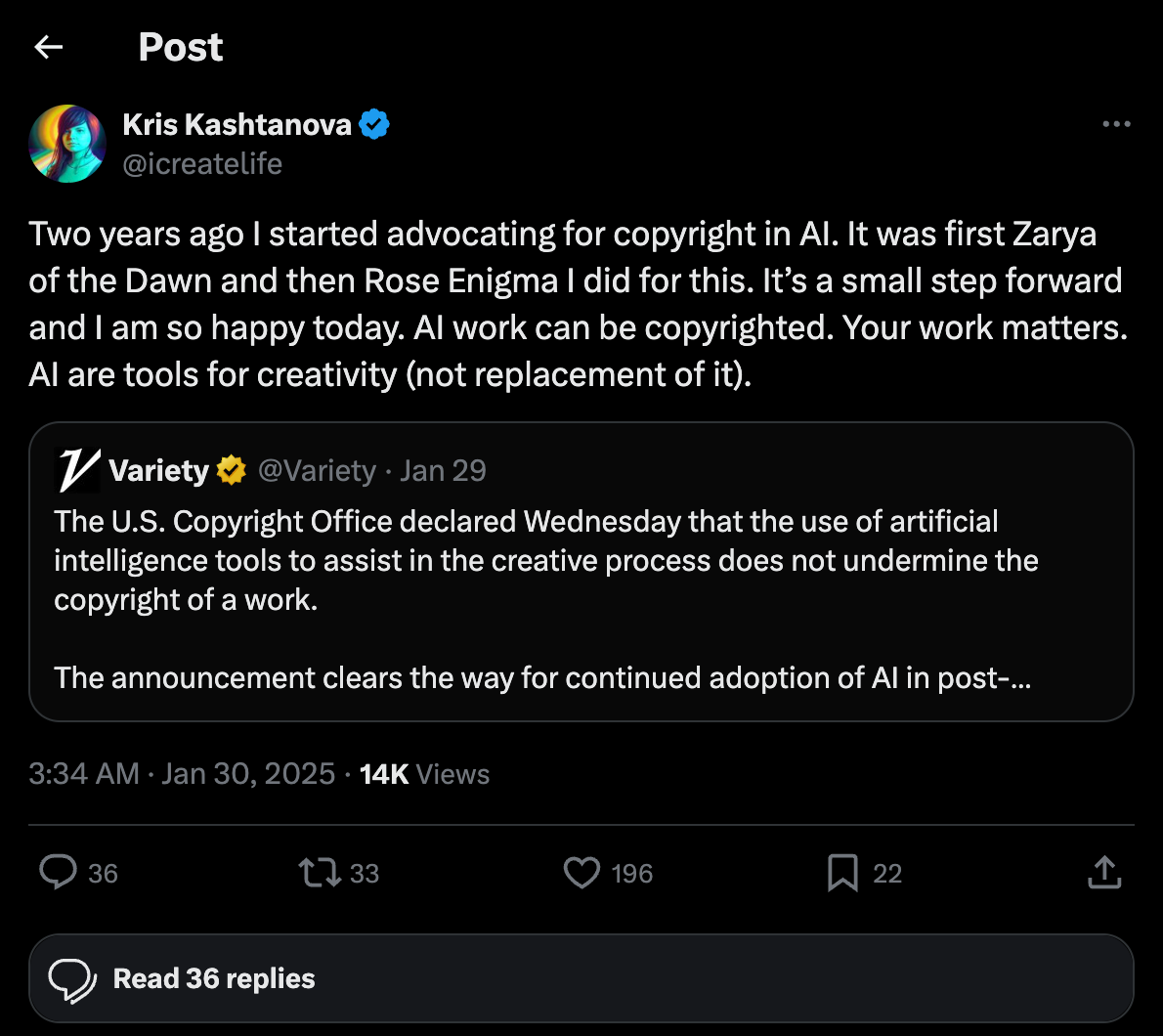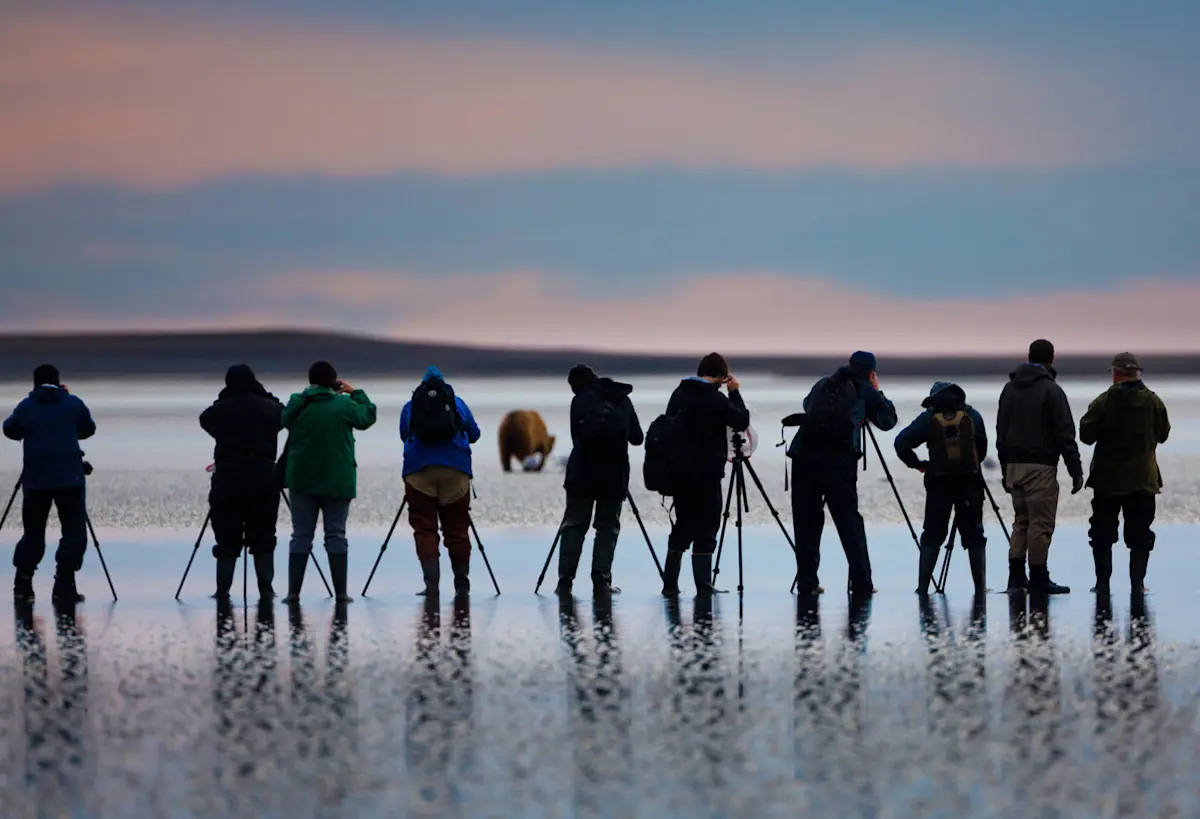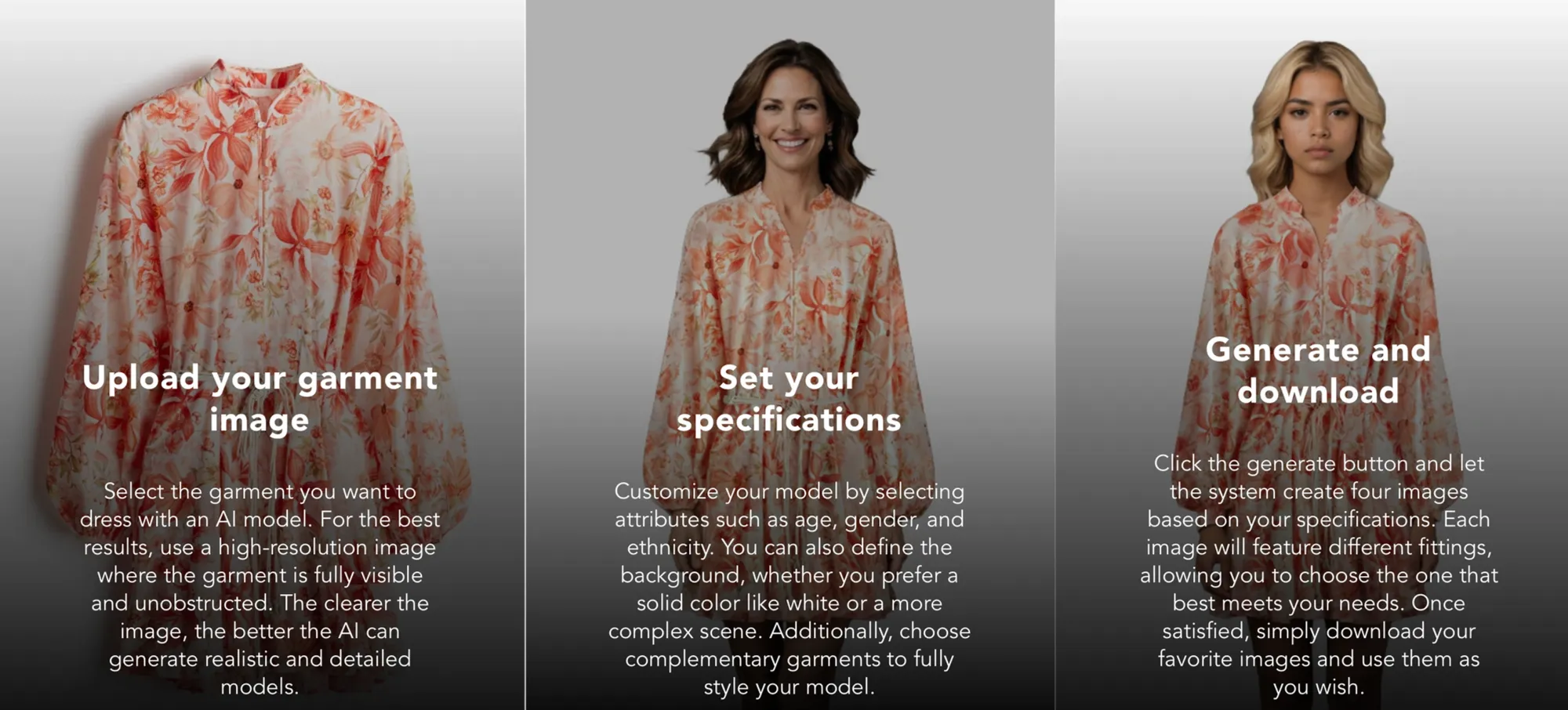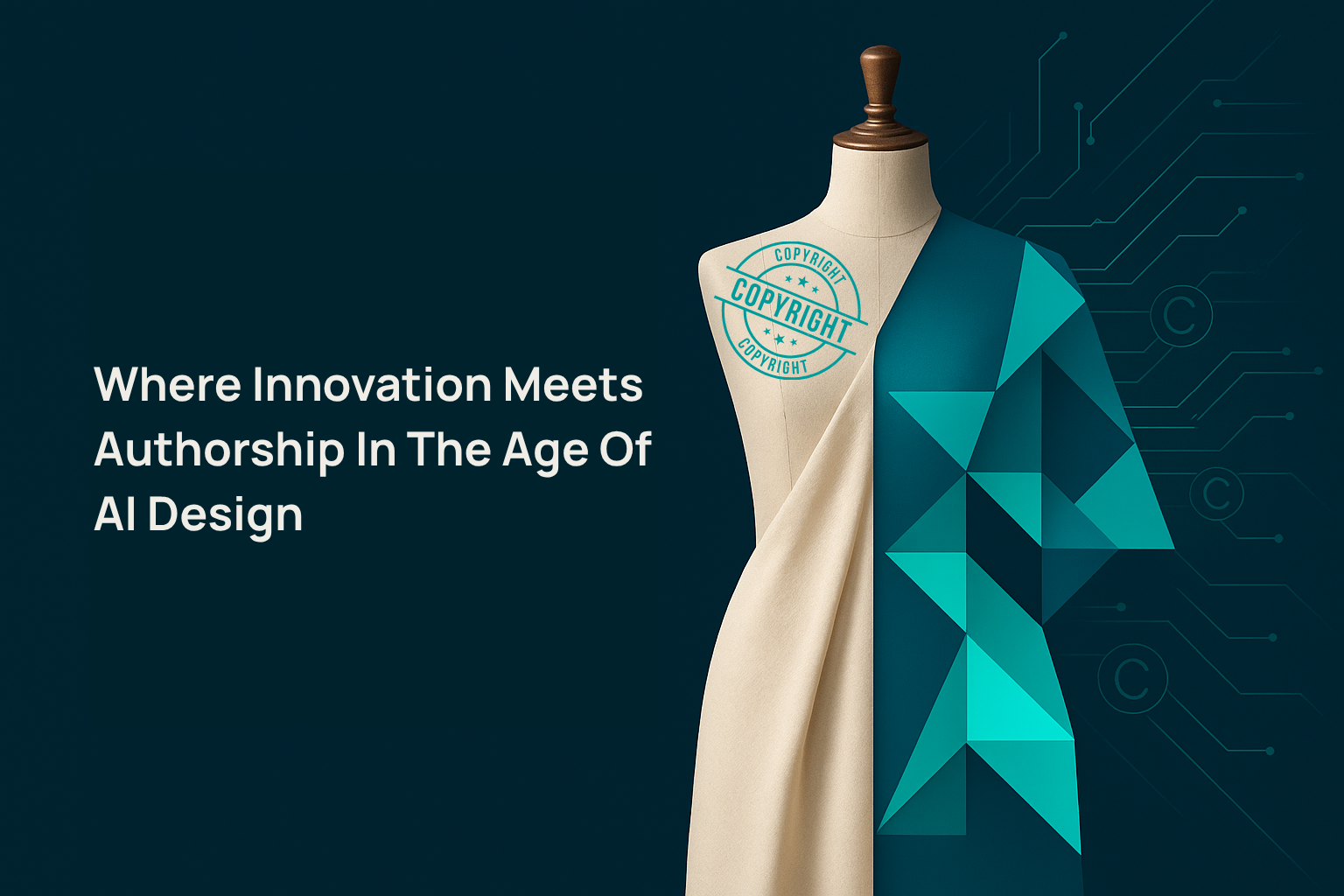Contents
The fashion industry has rapidly embraced artificial intelligence (AI) across its entire creative spectrum, from generating textile patterns and design concepts to creating marketing campaigns and virtual showrooms. AI is transforming the fashion industry, with tools now assisting designers in conceptualizing new ideas and helping photographers to create striking visuals, so brands can produce marketing content at unprecedented scale. But with this technological surge comes an urgent legal question: who owns the creative output when AI is involved?

However, the U.S. Copyright Office's recent guidelines on AI-generated content has introduced significant implications for how companies approach intellectual property protection. The Office's clarifications emphasize that copyright protection requires human authorship, creating new challenges for an industry increasingly reliant on AI-assisted creative processes.

According to McKinsey’s 2024 State of Fashion Report, more than half of global fashion brands now experiment with AI tools. The result is a hybrid creative landscape—part human intuition, part machine assistance—where the boundaries of authorship are constantly being redrawn.
What do the new regulations say?
The U.S. Copyright Office's guidance establishes a fundamental principle that profoundly impacts creative industries: copyright protection requires human authorship. This outlines clear distinctions that directly impact how companies can protect their AI-assisted creations. Works produced solely by machines or AI systems can’t qualify for copyright registration, regardless of their creativity or commercial value.
AI vs. Human Authorship: What’s Protected?
The Copyright Office outlines three key scenarios where AI-generated material can apply for, and receive, an official certificate of copyright from the office:
- When human-authored content is incorporated into the AI output.
- When a human significantly modifies or arranges the AI-generated material.
- When the human contribution is sufficiently expressive and creative.
In addition, the Copyright Office makes clear that using AI in the creative process does not disqualify a work from copyright protection. AI can assist with:
- Editing and refining text, images or music.
- Generating drafts or preliminary ideas for human creators to shape.
- Acting as a creative assistant while the human determines the final expression.

In practice, that forces fashion professionals to rethink their workflows:
- Designers using AI for ideation must document how they refine, alter, or build upon those ideas.
- Photographers relying on AI-enhanced visuals must show their own artistic decisions in composition, lighting, and editing.
- Marketing teams using AI copy must demonstrate human direction and brand contextualization.
How fashion's creative pipeline is affected
Photography and visual representation
AI has reformed how brands create compelling imagery, from automated image editing and color correction to generating entirely new concepts and creating virtual models for campaigns. However, this new guidance places creative control at the centre of copyright protection, making their role crucial in transforming AI-generated elements into protectable photographic works.

Fashion brands need to contemplate the distinction between copyrightable and non-copyrightable AI-assisted fashion photography scenarios. A photographer who uses AI to generate initial composition ideas, then applies their creative vision to lighting, styling, post-processing, and artistic interpretation would likely maintain copyright protection over the final photograph. Their substantial creative input in directing the shoot, making artistic decisions, and transforming the AI-generated concept into a unique visual expression demonstrates the human authorship required for protection.
This interpretation aligns with how the U.S. Copyright Office has begun evaluating AI-assisted creative works. In December 2023, a U.S. student photographer submitted an image he had created by taking his own photograph and then using an AI tool to apply a filter inspired by Van Gogh’s Starry Night. The USCO Review Board determined that the final image was not copyrightable, because the photographer’s original human authorship could not be clearly distinguished from the AI-generated artistic effects.

The case illustrates how the Office assesses copyright eligibility in hybrid works: when the AI’s contribution merges inseparably with the human’s, protection cannot be granted. Conversely, when a creator’s personal decisions—through directing, composing, or editing—are demonstrably identifiable, that human authorship remains protectable under U.S. law.
This distinction has significant implications for licensing arrangements. As MPB, a leading online marketplace for used camera equipment, explains,
“An image license is a contract defining the conditions of use for an image. This is between the image’s author—that’s you, the photographer—and the person who wants to use the image. The license will cover how and for how long the image will be used. An image license doesn’t change who owns the image. That’s always the copyright holder. Instead, the image license determines circumstances under which an image can be used by a customer or third party.”
Fashion design and textile creation
Designers increasingly use AI to generate ideas, motifs and even fully rendered garment concepts. According to McKinsey’s State of Fashion 2024 report, up to 25 percent of the potential value of AI in fashion will come from the creative side. This underscores just how integral human creativity remains, even as AI becomes embedded across the design workflow.
Yet, under the Copyright Office’s framework, the mere generation of a design by an AI model, even with designer-supplied prompts, could mean they’re not protected. To navigate this, fashion designers need to emphasize their hand in the process, whether it’s through sketching over outputs, iteratively refining AI-generated concepts, or embedding personal stylistic decisions.
Many popular AI platforms now actively encourage this kind of human-guided iteration. For example, Midjourney offers features like “Vary Region” and “Remix Prompting,” which allow users to select and regenerate specific areas of an image using modified prompts. In the Getting Started section of its website, Midjourney demonstrates how creators can rework composition, color, or texture—effectively merging machine assistance with human creative control.
Beyond idea generation, AI tools are also reshaping how designers visualize finished garments. A strong example is Modelia.ai’s “Flatlay to Model” feature, which transforms flat-lay apparel images into photorealistic visuals worn by digital models. Instead of relying on time-consuming photoshoots or 3D modeling, designers can upload a flat-lay image—like a dress or shirt laid out on a surface—and instantly generate high-quality visuals showing how the garment looks on a lifelike model.

This allows creative teams to preview fit, silhouette, and styling variations early in the design process, streamlining both design validation and marketing preparation.
Designers might contemplate maintaining a design journal, saving successive iterations, or documenting decision-making steps to ensure they’re supporting copyright claims and also reinforce their unique contribution in an era of machine-assisted creativity.
Marketing and advertising content
AI’s reach extends beyond the actual design of fashion to encapsulate branding and marketing, where it’s being used to write product descriptions, generate social media posts, and even produce digital personas like virtual influencers to achieve better user experience.
We’ve seen firsthand how AI is reshaping marketing workflows. According to the Adobe 2025 AI and Digital Trends Report, 86% of marketing leaders say generative AI will significantly increase content speed and volume—a sign of how quickly these tools are becoming embedded in daily brand operations. In fact, Adobe’s research also found that 65% of marketing practitioners have already started using AI agents to automate repetitive processes such as tagging assets, assigning tasks, and reviewing content.

Here, human authorship plays a pivotal role—a marketing strategist who just relies on AI chatbots to draft their captions could find their materials ineligible for copyright. When creatives provide detailed direction, rework outputs, and contextualize the content AI puts out within a broader brand narrative, their work is more likely to be protected.
Fashion brands will need to rethink their marketing workflows to ensure that AI remains a tool for productivity and ideas rather than a replacement for genuine creativity. Strategists, copywriters, and content creators should assert their role in guiding the technology and shaping the final message.
Looking ahead: AI, fashion, and the future of copyright
The Copyright Office’s current stance is just the beginning of a more comprehensive rethinking of intellectual property in a digital era. For the fashion industry, it presents a dual challenge: harnessing the innovation that AI brings, while preserving the rights of human creators.
Future legal battles will likely address questions such as how much influence a designer must exert over an AI to claim ownership, or whether AI-generated datasets infringe on existing copyrighted works. There’s already a need for policymakers to strike a delicate balance—one that encourages creative exploration without undermining the protections that enable original expression.
The future of fashion belongs to those who champion transparency, meticulous documentation, and a deep respect for human-led artistry. AI will continue to shape how garments are designed, produced, and marketed, but it’s not a replacement for human creativity, just a tool that can enhance it. Fashion is, at its core, a reflection of human culture, emotion, and identity. AI may be able to streamline processes and open new frontiers of innovation, but those who stay grounded in authenticity, ethical practices, and the irreplaceable value of human vision will see the biggest successes.
Other basic FAQ's
1. Can fashion designers copyright AI-generated designs under U.S. law?
Not directly. The U.S. Copyright Office has clarified that only works created with significant human authorship are eligible for copyright. This means designers who use AI tools must demonstrate their own creative input, such as refining, sketching over, or reinterpreting the AI-generated concept.
To strengthen ownership, designers should document their process and highlight personal contributions.
Learn more: U.S. Copyright Office update and VentureBeat’s explainer on human contribution in AI art.
2. What counts as “human authorship” when AI assists in fashion design or photography?
Human authorship refers to creative decisions that shape the final output, like directing lighting in a shoot, refining AI-generated visuals, or editing and composing the final layout.
For example, in the Sahni’s SURYAST (2023) case, copyright was denied because AI-altered elements couldn’t be clearly separated from the photographer’s input. Read the case: SURYAST decision PDF
If you’re a photographer, here’s a helpful resource on how to license your images.
3. How are AI tools changing the creative process for fashion designers in 2025?
AI tools are now part of every stage, from ideation to visualization. Designers use generative platforms like Modelia.ai to turn flat-lay apparel images into photorealistic visuals, and features like Midjourney’s “Remix Prompting” allow human-guided experimentation.
Still, human direction remains essential for copyright protection and authentic storytelling.
Explore the most popular AI tools used by fashion designers in 2025 or try Modelia.ai for visualization workflows.
4. If AI creates part of my marketing content, can I still own the copyright?
Yes, but only if your team contributes substantial creative direction. For instance, rewriting AI-generated captions, aligning tone with brand identity, or customizing visuals qualifies as human authorship. Marketers relying fully on AI agents without intervention may risk losing copyright protection.
According to Adobe’s 2025 Digital Trends Report, 86% of marketing leaders say AI increases content speed, but human strategy still defines originality.
5. What should fashion brands document to protect AI-assisted creations?
Brands should maintain a digital audit trail of their creative process:
- Original prompts or concept sketches
- Notes on human edits and decision-making
- Version histories or layered design files
This ensures transparency when proving authorship for copyright claims or licensing. Documentation also helps differentiate between machine-generated output and human creative contribution.
Related read: How Artificial Intelligence Is Revolutionizing the Fashion Industry
6. How will the U.S. Copyright Office’s AI stance shape the future of fashion innovation?
This policy will encourage greater transparency, co-creation, and ethical use of AI in fashion. Designers and brands will need to balance automation with individuality, treating AI as a tool, not a replacement.
The evolving law might soon address whether AI-trained datasets infringe on existing copyrighted designs.
Read more on how tech innovations are redefining fashion in IoT: Redefining the Future of Fashion
7. What can fashion professionals learn from recent copyright controversies?
Cases like SURYAST (2023) and discussions by creators such as @icreatelife on X highlight how easily human authorship can blur when using AI filters or generative edits.
The key takeaway: always retain creative control, document your involvement, and seek legal clarity before commercial use.
For a deeper understanding of how AI is reshaping authorship debates, check VentureBeat’s coverage.



